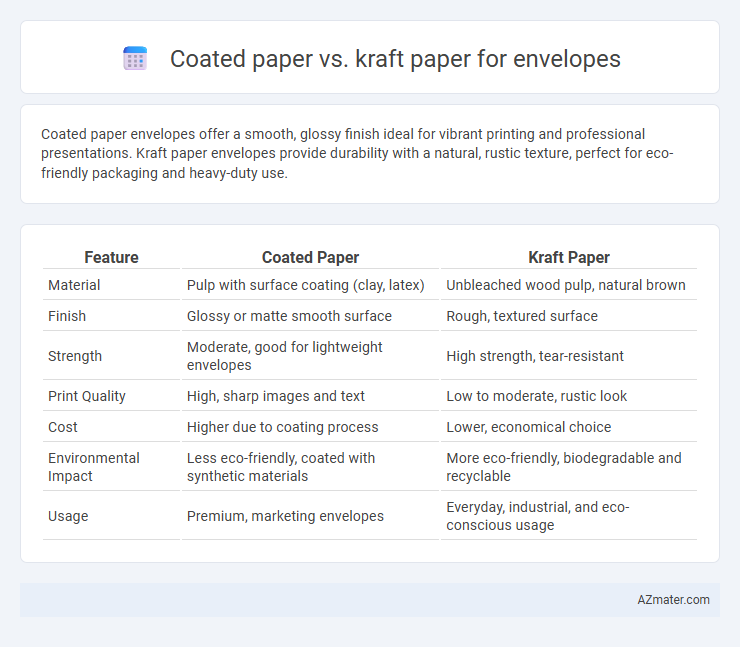Coated paper envelopes offer a smooth, glossy finish ideal for vibrant printing and professional presentations. Kraft paper envelopes provide durability with a natural, rustic texture, perfect for eco-friendly packaging and heavy-duty use.
Table of Comparison
| Feature | Coated Paper | Kraft Paper |
|---|---|---|
| Material | Pulp with surface coating (clay, latex) | Unbleached wood pulp, natural brown |
| Finish | Glossy or matte smooth surface | Rough, textured surface |
| Strength | Moderate, good for lightweight envelopes | High strength, tear-resistant |
| Print Quality | High, sharp images and text | Low to moderate, rustic look |
| Cost | Higher due to coating process | Lower, economical choice |
| Environmental Impact | Less eco-friendly, coated with synthetic materials | More eco-friendly, biodegradable and recyclable |
| Usage | Premium, marketing envelopes | Everyday, industrial, and eco-conscious usage |
Introduction to Envelope Paper Choices
Coated paper envelopes offer a smooth surface ideal for high-quality printing and vibrant color reproduction, enhancing brand presentation and professional appeal. Kraft paper envelopes provide durability and eco-friendliness with their natural, recycled fibers, making them suitable for organic or rustic aesthetics. Choosing between coated and kraft paper depends on the desired balance of visual impact, strength, and environmental considerations in envelope production.
What is Coated Paper?
Coated paper is a type of paper that has a smooth, glossy, or matte finish achieved by applying a coating of materials such as clay or polymer to its surface, enhancing ink holdout and print quality. It offers superior brightness and color vibrancy compared to uncoated papers, making it ideal for high-quality printing applications like marketing envelopes. This coating also provides resistance to dirt and moisture, ensuring letters and documents inside the envelope remain protected.
What is Kraft Paper?
Kraft paper is a durable, unbleached paper made from wood pulp using the kraft process, known for its high tear resistance and strength, making it ideal for envelopes requiring durability. Unlike coated paper, which has a smooth, glossy finish for better print quality, kraft paper offers a natural, rustic appearance with excellent environmental benefits due to its recyclability and biodegradability. Its robust fibers provide superior protection for mailing and packaging, especially in industrial and eco-friendly applications.
Appearance and Texture Comparison
Coated paper offers a smooth, glossy finish that enhances print clarity and vibrant colors, making it ideal for premium, visually striking envelopes. Kraft paper features a natural, rustic texture with a matte surface, providing a sturdy and eco-friendly appearance suited for casual or vintage-style correspondence. The tactile difference is significant, as coated paper feels slick and polished, while Kraft paper delivers a coarse, organic touch that emphasizes durability.
Durability and Strength Differences
Coated paper offers a smooth surface with moderate durability, making it ideal for printed envelopes where aesthetics are important but heavy-duty strength is not required. Kraft paper is renowned for its superior strength and tear resistance due to its unbleached fibers, providing enhanced durability for envelopes used in heavy mailing or packaging. The natural toughness of Kraft paper makes it preferable for protecting contents during transit, while coated paper prioritizes print quality over structural resilience.
Printing Quality: Coated vs. Kraft
Coated paper envelopes provide a smooth, glossy surface that enhances ink absorption, resulting in sharper, more vibrant printing ideal for high-resolution graphics and detailed designs. In contrast, Kraft paper envelopes have a rougher texture and porous surface, causing ink to spread slightly and colors to appear muted, which suits rustic or eco-friendly branding but limits printing precision. Choosing coated paper maximizes print clarity and color accuracy, while Kraft paper offers a natural, textured look with a more organic print finish.
Environmental Impact and Sustainability
Coated paper envelopes offer a smooth surface ideal for high-quality printing but typically involve chemical treatments and coatings that make recycling more challenging and increase environmental impact. Kraft paper envelopes, made from unbleached, recycled fibers, provide superior biodegradability and are easier to recycle, supporting sustainable practices and reducing landfill waste. Selecting kraft paper envelopes aligns with eco-friendly packaging trends by minimizing resource use and promoting circular economy principles.
Cost Analysis of Coated and Kraft Paper
Coated paper for envelopes incurs higher production costs due to its additional surface treatment and finishing processes compared to kraft paper, which is less processed and more economical. Kraft paper's cost-effectiveness stems from its natural fibers and minimal processing, making it ideal for bulk and eco-friendly packaging solutions. Despite higher upfront costs, coated paper offers superior print quality and durability, potentially reducing overall costs for premium branding applications.
Ideal Applications for Each Paper Type
Coated paper envelopes are ideal for marketing materials, invitations, and retail packaging where a smooth, glossy finish enhances visual appeal and offers print clarity. Kraft paper envelopes suit everyday mailing, heavy-duty shipping, and eco-friendly packaging due to their durability, natural texture, and recyclability. Choosing coated paper supports brand presentation and high-impact graphics, while kraft paper prioritizes strength and sustainability in envelope use.
Choosing the Best Paper for Your Envelopes
Coated paper offers a smooth, glossy finish ideal for vibrant printing and a professional look, making it perfect for marketing or formal invitations. Kraft paper provides a rustic, sturdy texture that enhances durability and eco-friendly appeal, suitable for casual or sustainable branding. Select coated paper for sleek appearance and vibrant graphics, or choose kraft paper for strength and natural aesthetics in your envelopes.

Infographic: Coated paper vs Kraft paper for Envelope
 azmater.com
azmater.com